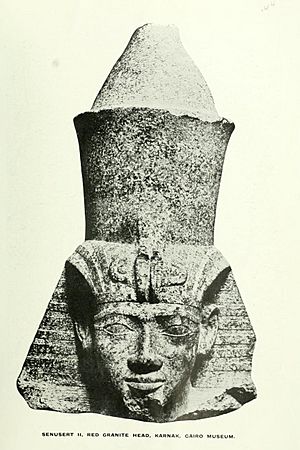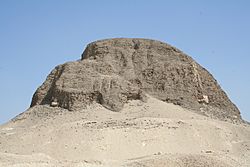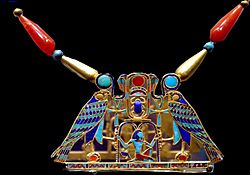Senusret II facts for kids
Quick facts for kids Senusret II |
|
|---|---|
| Senwosret II, Sesostris II | |

Head of a statue of Senusret II from Karnak
|
|
| Pharaoh | |
| Reign | Co-regent of five years; sole reign of around fifteen years. (Twelfth Dynasty) |
| Predecessor | Amenemhat II |
| Successor | Senusret III |
| Consort | Khenemetneferhedjet I, Nofret II, Itaweret (?), Khenmet (?) |
| Children | Senusret III, Senusret-sonbe, Itakayt, Neferet, Sithathoryunet |
| Father | Amenemhat II |
| Burial | 29°14′10″N 30°58′14″E / 29.23611°N 30.97056°E |
Khakheperre Senusret II was an important pharaoh (king) of ancient Egypt. He was the fourth ruler of the Twelfth Dynasty. This was a powerful family of kings who ruled Egypt for a long time. Senusret II ruled from about 1897 BC to 1878 BC.
He built his pyramid at a place called El-Lahun. Senusret II was very interested in the Faiyum oasis, a fertile area in Egypt. He started a huge project to bring water to more land there. This involved building a dike and many canals from Bahr Yussef to Lake Moeris. His goal was to create more farmland. This project was so important that Senusret II moved the royal burial grounds from Dahshur to El-Lahun. This new location became the main political center for the 12th and 13th Dynasties. The king also created the first known workers' village in the nearby town of Senusrethotep, also known as Kahun.
Unlike the pharaoh who came after him, Senusret II got along well with the local governors, called nomarchs. These governors were almost as rich as the pharaoh himself! We know about his sixth year as king from a painting in the tomb of a local governor named Khnumhotep II at Beni Hasan.
Contents
Senusret II's Time as King
Ruling with his Father
Sometimes, an Egyptian pharaoh would rule alongside his son. This is called a "co-regency." It helps the son learn how to be king and makes sure there's a smooth change of power. Experts who study ancient Egypt, called Egyptologists, have different ideas about how long Senusret II ruled with his father, Amenemhat II.
Some believe Senusret II ruled with his father for about three to five years before becoming the only king. One piece of evidence is a stone carving found at Konosso. It mentions dates for both Senusret II and Amenemhat II, suggesting they ruled at the same time.
How Long Did He Rule?
Figuring out exactly how long ancient pharaohs ruled can be tricky. The Turin King List, an ancient document, suggests Senusret II ruled for 19 years. However, the latest date found on any object from his reign is his 8th year as king.
Some experts think he only ruled for about 9 or 10 years. But others, like Frank Yurco, argue that 19 years makes more sense. They point out that Senusret II built a complete pyramid complex at Kahun. Building such a large project, even with mudbrick cores, would have taken at least 15 to 20 years. This suggests he must have ruled for a longer time.
Today, many Egyptologists lean towards a shorter reign of 9 or 10 years because we haven't found evidence of him ruling longer. However, the exact length of his rule is still a puzzle.
Projects in Egypt
The Faiyum Oasis is a special region in Middle Egypt that has been lived in for thousands of years. During the Middle Kingdom, it became a very important place. Pharaohs worked on many projects to turn Faiyum into a rich area for farming, religion, and even a kind of resort. It was located about 80 kilometers (50 miles) southwest of Memphis and had good farmland around Lake Moeris.
Senusret II started a big project to use the natural resources of this marshy area for hunting and fishing. He built an irrigation system with a large dike and many canals. These canals took water from Lake Moeris to new areas. The land that was reclaimed from the water then became farmland. This project was continued by later pharaohs and became very successful under his grandson, Amenemhat III.
During this time, people also greatly honored the crocodile god Sobek.
Activities Outside Egypt
Senusret II's time as king was peaceful and prosperous. There are no records of him leading military campaigns. Instead, trade between Egypt and nearby countries in the Near East grew a lot.
During his reign, paintings in the tomb of an official named Khnumhotep II show groups of foreigners from Western Asia visiting the pharaoh. They brought gifts. These visitors were likely from Canaan or were Bedouin people. They are called Aamu in the paintings. One important leader among them is even called Abisha the Hyksos. This is the first time the name "Hyksos" appears in history.
Who Ruled Next?
There isn't much clear proof that Senusret II ruled at the same time as his son, Senusret III. One small piece of evidence is a scarab (a type of beetle-shaped charm) with both their names on it. Some experts think that Senusret II's last year as king might have been counted as Senusret III's first year. This would make it seem like they ruled together, even if they didn't for very long.
Most experts now believe that if there was any overlap in their reigns, it was only for a few months. It's clear that Senusret III became the next pharaoh after Senusret II.
Amazing Treasures from the Tombs

In 1889, an English Egyptologist named Flinders Petrie made an exciting discovery. He found a "marvellous gold and inlaid royal uraeus" (a cobra symbol worn by pharaohs) in a flooded room of Senusret II's pyramid tomb. This beautiful piece was likely part of Senusret II's burial treasures that had been stolen long ago. Today, you can see it in the Cairo Museum.
The tomb of Princess Sithathoriunet, who was a daughter of Senusret II, was also found. Inside, archaeologists discovered several amazing pieces of jewelry. These included two pectorals (chest ornaments) and a crown or diadem. These treasures are now on display at the Metropolitan Museum of Art in New York and the Cairo Museum in Egypt.
In 2009, Egyptian archaeologists announced they had found more mummies near the Lahun pyramid. These mummies were in brightly painted wooden coffins. They were the first mummies found in the desert sand around the pyramid.
Senusret II's Pyramid

Senusret II's pyramid was built differently from earlier ones. It had a framework of limestone arms, similar to his grandfather Senusret I's pyramid. But instead of filling it with stones, Senusret II used mud bricks. Then, the whole structure was covered with a layer of smooth limestone. The outer stones were held together with special interlocking pieces.
The builders dug a trench around the pyramid's center. This trench was filled with stones, acting like a drain to protect the pyramid from water damage. This shows that Senusret II was worried about water harming his tomb.
Around the main pyramid, there were eight smaller, solid structures called mastabas and one small pyramid. These were all inside the main wall of the complex. The wall itself was covered in limestone and decorated with special niches, possibly copying the design of Djoser's complex at Saqqara. The mastabas were empty inside, meaning they were likely symbolic tombs, not actual burial places. Flinders Petrie also explored the small pyramid but found no rooms inside.
The entrances to the underground rooms of the pyramid were on the southern side. This was unusual, as most pyramids had entrances on the northern side. This tricked Flinders Petrie for a while when he was looking for the entrance.
The builders had filled in the main entrance shaft after construction. They made one chamber look like a burial room to fool tomb robbers.
Another secret passage led to a vaulted room and a deep well. This might have been part of rituals for the god Osiris, or perhaps it was to find the water level. A passage then led north, past another room, and turned west. This led to an antechamber and the main burial chamber, which had a side room. The burial chamber was surrounded by unique passages that might relate to the story of Osiris's birth. A large sarcophagus (stone coffin) was found in the burial chamber. It was so big that it must have been placed there when the chamber was being built, before the roof was put on.
Much later, another pharaoh named Rameses II removed the limestone outer layer of Senusret II's pyramid. He wanted to reuse the stones for his own buildings and even left inscriptions saying he had done so.
|
See also
 In Spanish: Sesostris II para niños
In Spanish: Sesostris II para niños





